Hammertoes can come in various forms but there are three basic types:
1. Hammertoe: contracture is at the joint furthest from the tip of the toe.
2. Clawtoe: contracture is at both joints in the toe.
3. Mallet toe: contracture is at the joint closest to the tip of the toe.
Causes:
Most podiatrists would agree that the cause of hammertoes is not straightforward and is very individualized. It can be a genetic problem, secondary to trauma and disease such as rheumatoid arthritis and diabetes, due to poor mechanical positioning of the arch, poor walking mechanics and/or poorly fitting shoes. Bunion deformities may help create hammering of nearby digits because of crowding and positional changes. The list goes on and on.
In my family a curled under 4th and 5th toe is genetic. (Toes are counted from the big toe out, so the “pinky toe” is number 5.)
Can hammertoes be prevented? Unfortunately, no studies have ever demonstrated any conservative measures that can prevent hammertoes from forming. If a large bunion was corrected early enough it might prevent the 2nd toe from contracting, but other than that, most hammertoes occur slowly over time by forces that are impossible to control without extreme measures.
Complications from Hammertoes:
Hammertoes can be responsible for shifting the much needed fat pad at the ball of the foot forward so that the patient is actually walking on skin and bone alone resulting in significant pain. The deformity, when combined with a foot that is numb (insensate) say from diabetes or back injuries can result in wounds that are chronic and difficult to treat often resulting in amputation. For some people, hammertoes can be a serious cosmetic problem or a real source of pain either because of the shape of the toes, the inability to wear shoes or because of the thick calluses that can form because of the prominent toe rubbing on shoes and socks.
Treatment:
Conservative methods include buying shoes with a very roomy toe box (area around the toes) or having the shoes stretched (done in our office), having custom shoes made (normally for diabetics), buying shoes with flexible material to avoid putting excessive pressure on the prominent part of the toe, padding the toes with tube foam and sticky felt pads, wearing multiple layers of socks for extra padding, purchasing bracing devices that temporarily straighten the toe, pads to lift the end of the toe off the ground, and pads to flatten/protect the top of the toe. I could go on but you get the idea here.
Many of the pads above can be found at: www.ourdoctorstore.com/saltlake/store/index.asp?department_id=52
We can also stretch your shoes in our office at the source of pain as seen below: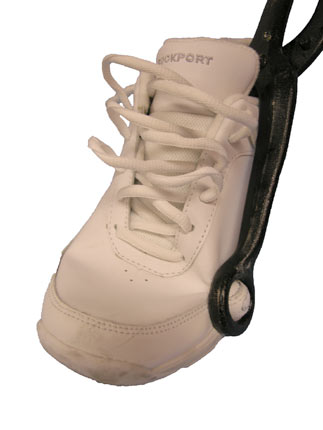 (image source)
(image source)
Surgical treatments include remodeling and fusing the joints that have become deformed and transferring tendons and releasing soft tissues that have shortened and contracted. To hold the surgeon’s work in place, sometimes a pin is introduced through the skin at the very end of the toe and driven through each bone segment to hold them in perfect alignment.
Recovery from surgery usually requires the patient to wear a special shoe to accommodate the pin at the end of the toe or if no pin is used, to protect the incision site. The patient is allowed to walk in a special post-op shoes or boot. If an externally protruding pin is used, the site is carefully maintained clean dry and protected for 6 weeks or so and removed in the office.
Several advances in the last 10 years have introduced the idea of implants for hammertoe correction. Some of my favorites include:
Pro-Toe: (www.wmt.com/footandankle/FA634-1110.asp) My only criticism is that the “christmas tree” end is not aggressive enough and I have seen this implant fail and allow the bones to spread apart.
Digifuse: (www.metasurg.com/digifuse.html)
I-Fuse (Orthopro) & Orthohelix Implant: I think these are the future of implants, with a device you can leave behind for greater stability and still have the option of the temporary wire placement without having to choose between the two.
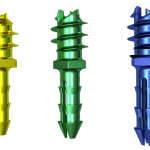
Truthfully, bones have very few nerves supplying their center so removing the long pin (if it was placed) isn’t any worse than a sharp pinch if anything. The pin placement is not always necessary. The decision to place a pin (k-wire) depends on the severity of the deformity and the preference of the surgeon. Also used are long screws through the length of the toe, wires, staples, plates etc.
Expected Outcomes:
The honest truth is that hammertoes are a tricky problem to correct. Even the perfect surgery can result in crooked toes years later. Success rates are fairly high however and depend on the methods of the surgeon. Always feel free to ask for success examples and levels of success that the surgeon has actually experienced. Any surgeon who says that he never sees complications is smoking something illegal.
The decision to have your hammertoe corrected completely depends on your situation. For some individuals, correcting the hammertoe may help avoid wounds and infection and possible amputations later on. For others, the risks of surgery may outweigh the benefits.
Advances in anesthesia make actual risk to general health for an average individual very small who undergo minor surgery. Any time surgery is more than skin deep, nerves can be injured, blood vessels compromised and infection may set in. I don’t mean to frighten you here, truthfully most surgeries comes off without a hitch, however complications do happen.
My point is this: Make sure you know the whole story, know your surgeon, and verify in your own mind that the possible outcomes are worth the risk. Always get a second opinion if you still have doubts. If you feel pressured to have elective surgery, you’re probably in the wrong office.
As always we invite questions, comments and the occasional criticisms…
Dan Preece, DPM
Salt Lake Podiatry Center P-LLC
Dan Preece, DPM & Darren Groberg, DPM


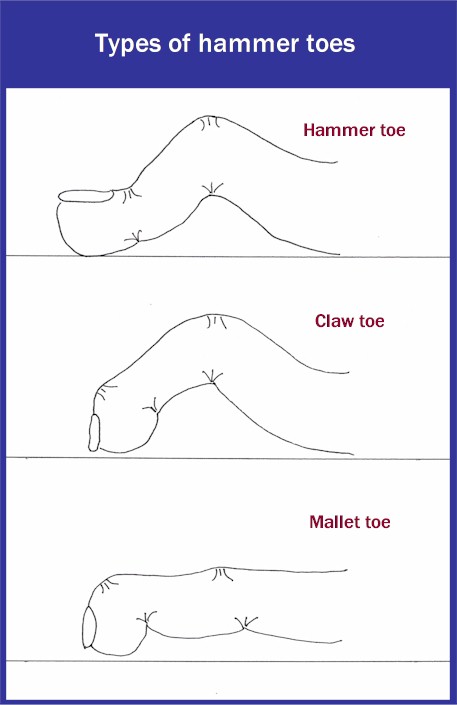
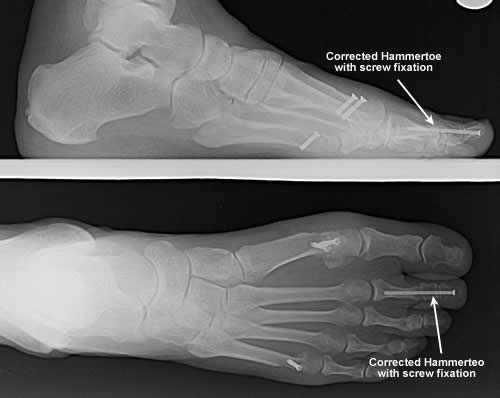
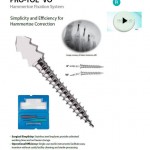
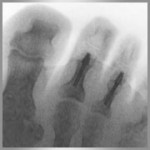
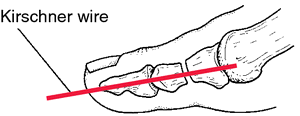


Hello Dr. Dan.
I was searching for information on foot surgery and its outcome and I was fortunate enough to come across your page. I read so many blogs with different opinions, but was still unsatisfied. I am suppose to have foot surgery on (hammertoes on my Rt foot) but I have been very nervous about the procedure. Oddly enough one of my concerns is that I feel a little pressured about having the procedure. I want to have it done, but I fear that the procedure is to severe. It there another way of removing corns without having this major procedure of cutting and reattaching bones? I know it sounds silly, but I need to be sure. Thank you.
If I understand you correctly your main concern is painful corns/calluses on the top (dorsum) of your hammertoes as well as the deformed toes themselves. Corns/calluses form in response to friction and pressure. Shoes that don’t allow enough space around the toes may cause painful calluses. You may try shoes with a large toebox or at least a flexible one. Lately I’ve been looking into shoes with a spandex upper that would put less pressure on bunions and hammertoes. I would be interested in hearing if shoes such as “Clara’s Clogs” have enough stretch to relieve this kind fo pain. If the deformity must be fixed and shoe changes are not enough for your satisfaction, then my next answer may not be to your satisfaction. The only way to truly fix a hammertoe in the long term, as far as current trends and research are showing, is to fuse the 2nd joint from the tip of the toe or both of the joints in the toe. The underlying problem with hammertoes is a imbalance between tendons. The only way to restore this balance is to transfer tendons (always a difficult question as to whether they will stay were you want them and do what you want them to do) or to fuse the proximal joint in the toe. The imbalance between tendons results from the tendons on top of the toe and bottom of the toe inserting into bones that do not oppose each other functionally as well as in the timing of when the muscles attached actually fire. Fusing the joint and/or transferring the offending tendons is the only way to properly address the imbalance of muscle strength that is buckling the joints and causing the deformity over the long term. Most Podiatrists have come to understand the above principle (I have of course left out many details here). You may find a surgeon or two who is willing to approach hammertoes without the bone cutting and fusing of joints with or without transferring tendons, but their outcomes are often very poor. The toe must be transformed into a body being acted on equally on each side by muscles in your leg or eventually your hammertoe will return or worse, come back more crooked than you can imagine. I hope this answers your questions. This is one principle I can absolutely stand behind. I have seen way to many really bad outcomes when the surgeon tries to attempt a quick fix and not look at the longterm consequences. If the surgeon can’t explain to you exactly why the procedure he is proposing must be done, then a second opinion is always your right as a patient. Good Luck!! Dr. Dan Preece